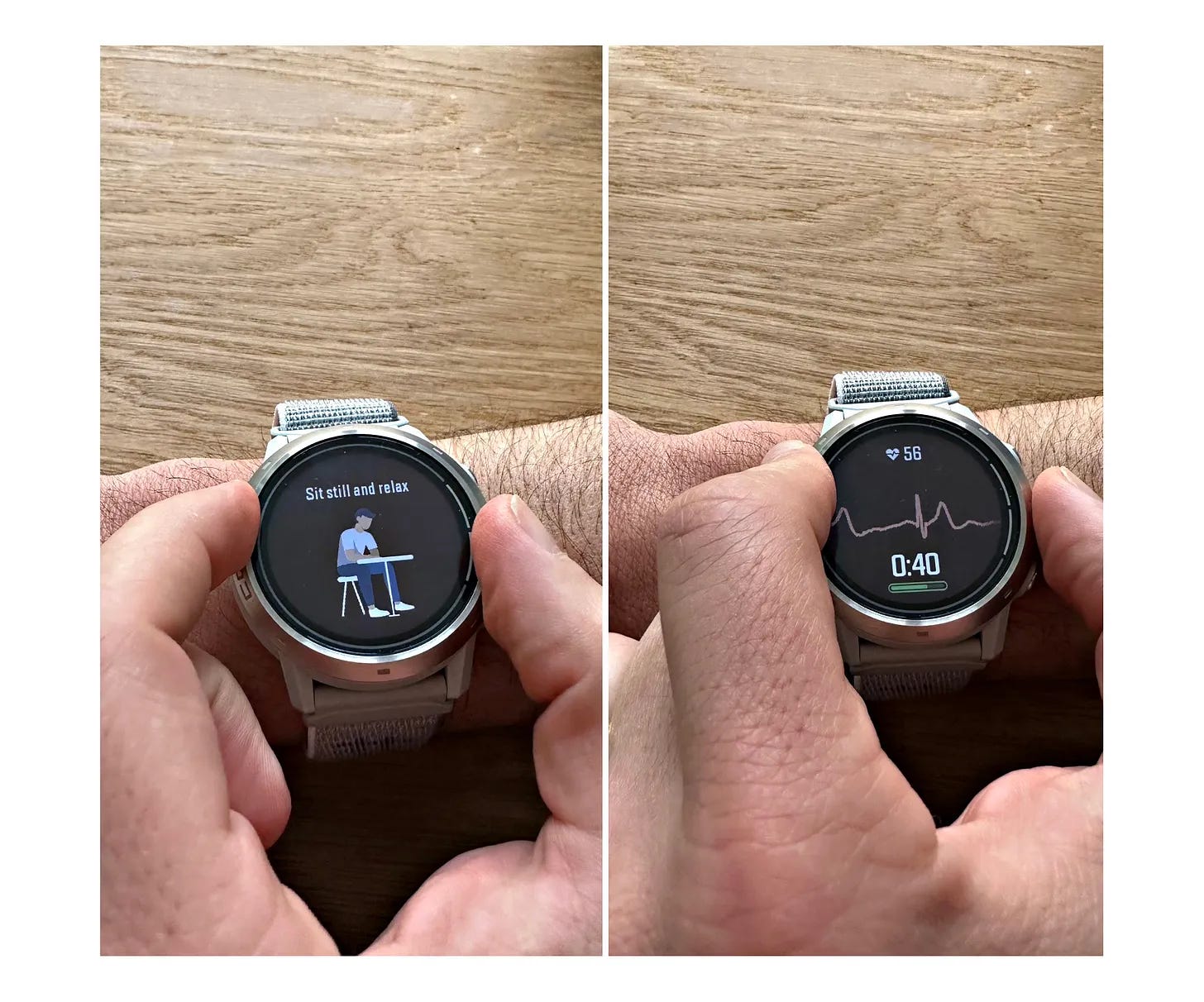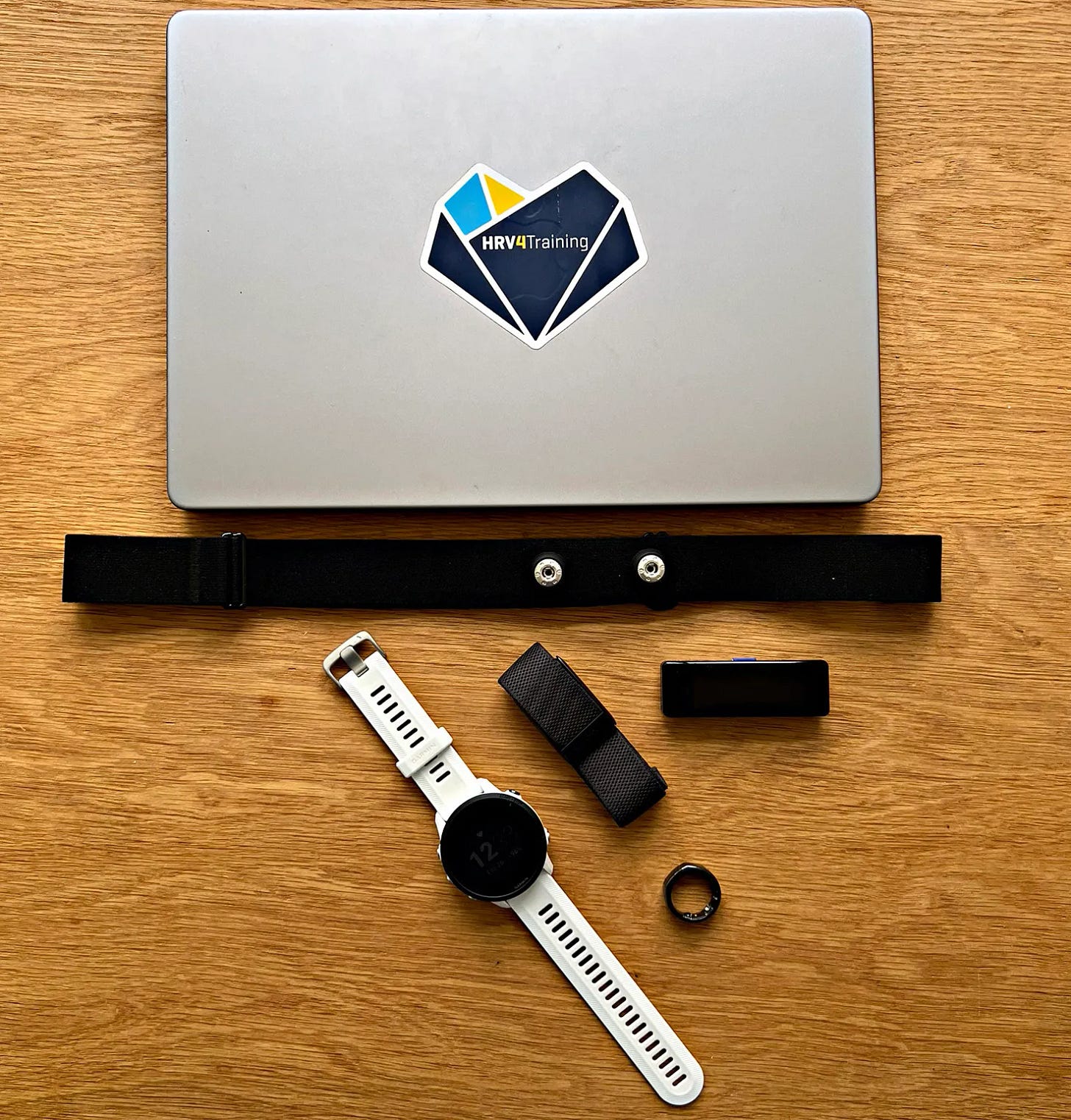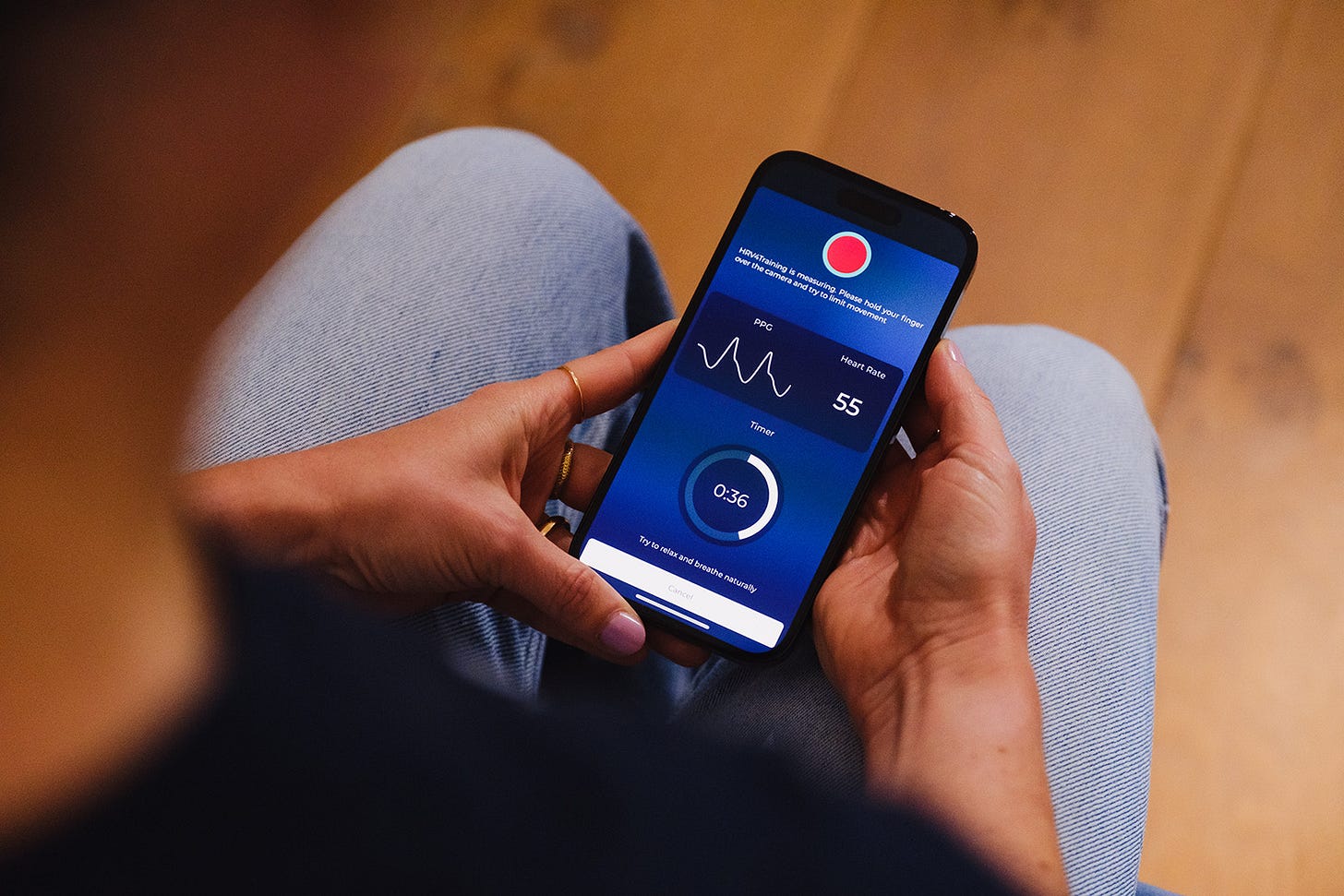Recommended sensors for heart rate variability (HRV) measurement in HRV4Training
a short guide
In this blog, I’d like to provide a list of the sensors we normally recommend for HRV measurement, which you can either pair directly with HRV4Training, or link via APIs, or whose data you can enter using manual input in the questionnaire.
These are all sensors that I have either tested or used and that I trust in terms of providing high-quality data.
I will start with sensors that can be used for morning measurements, as this is my preferred method (i.e. the one I consider more useful, especially for athletes), and then also cover sensors that can be used for night measurements.
If you are not sure about the differences between morning and night data, which is tightly coupled to the measurement protocol and body position, see also:
Heart rate variability (HRV) measurement position: lying down, sitting or standing?
Heart Rate Variability (HRV) measurement timing: morning or night?
Morning measurements
For morning measurements, we typically have two types of sensors available, optical and ECG based. Optical would be the camera or sensors with dedicated PPG sensors, like watches or armbands. ECG would be chest straps or watches that allow you to measure your ECG by touching a dedicated component with your other hand (e.g. Coros).
The sensors listed below implement standard protocols (apart from the Apple Watch) and therefore can be linked directly to HRV4Training for a morning measurement via Bluetooth.
TLDR:
Phone camera (iPhones and supported Androids).
Scosche Rhythm24 in HRV mode.
Coros Apex Pro 2 (or other Coros with ECG).
Apple Watch using the Breathe app.
Whoop in broadcasting mode.
Kyto HRM-2931 or the following versions.
Polar, Garmin chest straps.
I’ve highlighted my current favorites, the ones I use daily.
Optical
Camera
On iPhone, in general, I recommend using the phone camera. This is also what I use every day, and what I consider my “main measurement” (while I do take a few extra with different sensors mostly for testing purposes). I have shown countless comparisons with ECGs in the past (both in published literature and blogs), as well as with night data, highlighting the accuracy of this method. However, if you do not feel comfortable using this method, or if you struggle to obtain Optimal signal quality for one reason or the other, or if you have an Android phone that is not supported (the app will inform you), there are plenty of alternatives, as you can see below.
See also:

Scosche Rhythm24
The Scosche Rhythm24 is at this point quite old (maybe 6-7 years old already), but it remains the only sensor available on the market that does the following: it implements a heart rate mode, which you can use during exercise, and, it also implements an HRV mode, which you can use when completely still, e.g. for morning measurements. Given that all other companies went for proprietary solutions and proprietary protocols, this sensor remains one of the very few decent ones that can be used for HRV analysis with any third-party app. The lack of compliance to the standard Bluetooth heart rate profile by almost all other sensors is a real pity, as these companies fail to understand that there is a much bigger market for their sensors, beyond the somewhat underwhelming software solutions they sell (rant over!).
See also:
Apple Watch
The Apple Watch allows you to take a measurement using the optical sensor when using the Breathe app (one of the default ones under the Mindfulness suite or similar), which is then written to Health in terms of SDNN (an HRV feature) and the actual RR intervals. HRV4Training can then read the RR intervals and compute rMSSD (a better HRV feature). This process works well and the watch tends to be accurate for spot checks, contrary to the night data collected by the Apple Watch, which is often of poor accuracy and meaninglessly sampled (see later).
See also:
Whoop band
That’s right, you can use the whoop band to take a morning measurement, by putting the sensor in broadcasting mode. Surprisingly enough, the whoop is the only wearable that decided to comply to standards and allow for this type of measurement. The quality is good when used this way, as I covered here.
See also:
Kyto ear clip or finger sensor
This is an ear clip, which I tested a few years ago, and worked well for HRVs that weren’t too high. I have not tested the latest versions, and they might have a similar issue, but for most people, this is a good and relatively cheap sensor that also complies with standard protocols.
ECG
Coros Apex Pro 2
Coros has an ECG measurement in their watches (only some models), and this is at the moment my favorite measurement, together with the camera. It removes all the annoyances of chest straps (plus, chest straps are often not as good as advertised and often provide artifacted data, especially when used outside of exercise), but it still allows you to use ECG instead of PPG, which might be preferable in some cases or simply can make it easier to acquire high-quality data. You have to be very still though, just like when you use PPG.
See also:

Polar H10, Garmin Pro
Polar straps (H7, H9, or H10) are good sensors if you don’t mind wearing a strap in the morning. Make sure to always keep your strap humid / wet before using it (even just putting some water is often sufficient), or you might need gel if you struggle to get a good signal. Garmin straps (the ones that have Bluetooth connectivity, probably all of the new ones at this point), are also good for HRV measurement. They are not as durable in my experience (often they seem to be built to break the first time you need to change batteries, which is not the case with Polar), hence I tend to recommend Polar. There are other chest straps that work, from various brands, but I have not tested many of them and I am aware of many not working (e.g. Wahoo straps tend to be bad at HRV), and therefore I stick to recommending the two above.
Keep in mind that straps are far from perfect, and you should still use an app that provides signal quality metrics and is able to handle potential artifacts (either in terms of actual ectopic beats, or just the strap misbehaving).
Night measurements
For night measurements, the choice of sensor is driven by the following criteria:
accuracy: when measuring HRV, it provides a measurement that is very close to the reference HRV measured with e.g. an ECG at the same time.
sampling strategy: accurate sensors can still provide useless data if they sample at random times (e.g. the Apple Watch, the very last sensor you should use for this).
Not all sensors listed below can be linked to HRV4Training, but we have implemented a simple manual input mode where you can enter your night HRV from Garmin, Whoop, or else, as part of the questionnaire in the morning. Learn more, here.
TLDR:
Coros watch.
Oura ring.
Garmin watches.
Whoop band.
Also here I’ve highlighted the one I use.

Oura ring
The Oura ring provides accurate data and samples during the entire night. It’s as simple as that, if you prefer not to measure in the morning, then this is what I recommend. Measuring at the finger tends to be of superior accuracy due to closer proximity to blood vessels, and I also like the rigid form, which means you do not have something tightly strapped on you while you sleep (e.g. a wristband or watch). HRV4Training integrates with Oura’s APIs so that you can get your Oura data in our app automatically.
Garmin or Coros watches
Recent Garmin or Coros watches provide night rMSSD, which is of high quality in my experience. Unfortunately, Garmin has a weird way to report resting heart rate, using the lowest 30-minute window during the previous 24 hours, which sometimes misses the mark entirely. I discuss this in more detail here. We do not integrate with Garmin, but you can simply enter your night HRV in the questionnaire using manual input. We do integrate with Coros, and you can get your night HRV automatically in HRV4Training if you use a Coros watch.
Whoop band
The Whoop band since version 3, can be used for night HRV. Beforehand, the sensor suffered from an issue with sporadic sampling, which I discuss in greater detail here. Currently, the whoop remains more noisy than others in my experience, and also still processes the data in ways that do not give you access to the actual average, but to a weighted version. However, the differences are small, and longitudinal changes over time are similar to other sensors. We do not integrate with Whoop, but you can simply enter your night HRV in the questionnaire using manual input.
Others
Other sensors provide night HRV, however, due to sporadic sampling, or shorter time windows, or unclear processing, I tend not to recommend them. Among these, Apple Watch, Polar watches, and Fitbit sensors. This does not mean that these sensors are not good to get an idea of how HRV is changing over long time frames, but I consider them suboptimal for decision-making.
See also:
I hope this was informative, and thank you for reading!
Marco holds a PhD cum laude in applied machine learning, a M.Sc. cum laude in computer science engineering, and a M.Sc. cum laude in human movement sciences and high-performance coaching.
He has published more than 50 papers and patents at the intersection between physiology, health, technology, and human performance.
He is co-founder of HRV4Training, advisor at Oura, guest lecturer at VU Amsterdam, and editor for IEEE Pervasive Computing Magazine. He loves running.
Social:





Hello Marco, I appreciate you for providing all this information. Without it we might have great tools but would not be using their potential.
Since Oura and whoop are too expensive for me, I'm thinking about buying one of the devices you usually wouldn't recommend. I'm wondering why you don't recommend certain device, for example fitbits and Google pixels. Your criticism concerns
(1) sporadic sampling, or
(2) shorter time windows, or
(3) unclear processing".
However, as far as I understood (see source below)
(1&2) fitbits uses data from an entire night of sleep
(3) fitbit uses rMSSD to calculate hrv
Quote: "Fitbit uses the common formula called RMSSD to determine HRV from your recent heart-rate data. In the graph, your latest HRV measurement is from the longest sleep period over the past 24 hours. Only sleep periods greater than 3 hours are considered."
https://help.fitbit.com/articles/en_US/Help_article/1565.htm
What exactly do you not like about hrv readings from fitbit devices then?
Thank you.
Tino
Hi Marco & team, How do I connect garmin HRM pro to the app for HRV?
Thanks
Dennis